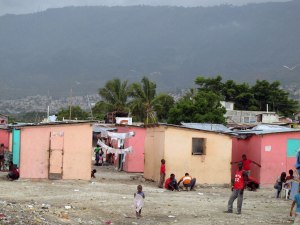It had been almost exactly eleven months since Brillant and I last visited the former inhabitants of the Route des Rails median tent camp (Route des Rails Follow-up, August 22, 2012) and two years since they moved into their new neighborhood that, on our most recent previous visit, was known as Brotherhood Village. Although the name has now changed to Camp Chavez, in honor of the late Venezuelan president, little else has. The steady deterioration we saw on our last visit has continued apace, abetted, if not directly caused, by the continued neglect and indifference of authority at every level.
A young woman resident led us to the home of an older man, who, although he holds no official title, seems to be the unofficial camp spokesman. He told us basically the same story we heard on our last visit, that Camp Chavez is a forgotten camp. No one, neither governmental authority nor NGO, comes to visit or offer aid. Even the elementary school that was provided by the Slovenian government and the Adventist Development and Relief Agency (ADRA) has not benefitted the camp inhabitants.
The spokesman complained that ADRA had hired teachers who were untrained solely because of their connections with the organization. In addition, he noted that the camp residents are expected to pay the teachers’ salaries, clearly an impossibility, if they want their children to go to school. Several other camp residents, who had gathered around, supported this story and added that the school now benefits, if a school with incompetent teachers can benefit anyone, the adjoining neighborhood.
Given the situation, I asked if the camp inhabitants could qualify for the roughly $400 stipend that the Haitian government is offering families to move out of tent camps. He replied that he hadn’t heard of that possibility, but that the situation is so bad that people are finding ways on their own to move, mostly by going to live with relatives or friends. After ten minutes or so, he reluctantly agreed to accompany us on a tour of the camp.
Walking around, dodging puddles of raw sewage, there being no functional sanitation system, we passed familiar sights. People were sitting or standing outside their homes cooking, washing clothes, playing dominoes and doing each other’s hair. Young children, some half, some totally, naked, played through the alleys. All of which just seems to show that life goes on, even under extreme duress, until it doesn’t.
After a few minutes, Johnny Sterling, one of the young men who had guided us last year, appeared, significantly the worse for wear. Whereas last year he was nicely dressed and healthy looking, now he’s rail thin, his ragged clothes hanging off of him. Whether he’s ill or just malnourished, another woman told us she was hungry while tapping her stomach, the change was striking. He accompanied us for the remainder of our visit, benefitting me particularly, as people were much more willing to allow me to photograph them with him essentially vouching for me.
It’s hard to see where, if anywhere, these people go from here. They appear to be on their own to make whatever future they can for themselves. And, in truth, this is the case for the vast majority of Haitians, assistance from any quarter, governmental or non-governmental, being rare and unreliable. Nevertheless, that truth doesn’t make life any easier for the residents living among the squalor of Camp Chavez, who were, at a time that seems ever longer ago, promised support in building a better future. (For more pictures, www.vichinterlang.com).




